Well after pouring rain and then totally clear sky’s all the right elements fell into place to put the Lee Big Stopper 3.0 Neutral Density Filter to the test and to compare it to the B+W 77mm ND Neutral Density 3.0
screw in filter.
With my initial review on the filter I have based my testing on the images produced during the middle of the day and I just wanted to show the filters basic difference from the B+W 3.0 (10 stop). Also I have shot the images with the Canon 5D MkII on the 24 – 70 f2.8 lens so I may make the odd reference to some of the systems with that camera setup. All my testing is done on my hardware calibrated monitor. So you may have different results if your not calibrated.
First impressions:
First off for all those who are looking to buy one, the filter comes wrapped in tissue paper with a special seal “Warning to not accept it, if the seal is broken” not sure what that is about but anyway it comes with its own black padded bag which is nice. The filter is glass which is great (wish the ND grad filters were). The filter inserts easily into the Lee filter holder and the special foam to make it light tight rubs gently on the filter holder which gives me the impression that worrying about foam coming off over time due to use isn’t an issue. At first inspection when the filter is inserted you might think it wont be light tight but when you clip it onto the adapter ring it is. But I will be totally convinced when I see my film shots with the filter.
It’s comparison to the B+W 3.0 (10 stop) screw in filter:
Straight out of the camera you will instantly see that the Big Stopper is cooler over the B+W filter by exactly 1000 kelvin according to Adobe Camera RAW (ACR). Big Stopper is 5580K and B+W is 4580. Whats weird is how the B+W’s image looks warmer but has a cooler colour temp and vise versa, but makes sense if you think about it. With each of these shots they are straight out of the camera and where captured on Auto White Balance.
Now whats worth noting is what happens if you adjust the colour temp by 1000 k in each shot in ACR. So for the Big Stopper I will change it from 5580 to 6580 (this is to warm it up to match the B+W image) and with the B+W I have changed it from 4580 to 3580 to cool it to match the Big Stopper. The results are in the next two images.
I personally found the Big Stopper warmed better and the B+W cooled better in ACR. Now that’s weird… but subject to personal taste.
When shooting with the Big Stopper and then changing it with the B+W with the same exposure settings there is negligible change in the histogram especially in the area of it either brightening or darkening the image.
Auto focus with the Big Stopper either with the AF-On button in live view or the old fashioned way I found is the same… almost impossible. So manual live view focusing or without the filter is the way to go. Whats great with the Big Stopper was on my first shot with it I accidentally left the camera on Auto focus so when I went to take the shot it started to search for a focus point. Fixing this error was simple, pulled the filter out, focused and I was back in action. Making this error with the B+W is a pain in the ass, even more so if you have the lee filter kit with a ND grad in there as well.
This is my first shoot with the filter and on first impressions and results I think it is a great product with no faults. If you already owned a B+W 10 stop I would only buy the Big Stopper if you wanted the freedom of a slide in and out 10 stop filter and the ability to reduce vignetting that may result if you have the B+W screwed in and then the Lee Filter system attached.
What about on film:
I also shot images on slide film with the Fuji G617 with both 10 stop filter systems. I have a suspicion that one will be clearly better over the other and seeing that it is film it wont have the RAW flexibility for adjustment. After seeing the results on digital and also from shooting long exposure with the B+W 10 stop on slide film before I think the B+W will come out on top over the Big Stopper. Time will tell I guess when I have the film processed next week.
So if this is Part 1 what will be in Part 2:
Well seeing that I shoot film I will make part two my review of the filter on slide film. I have shot with the B+W 10 stop for about 6-7 years… long before it became the rage with digital. So for you film shooters keep an eye out for this next review.
Any questions or feedback is most welcome.

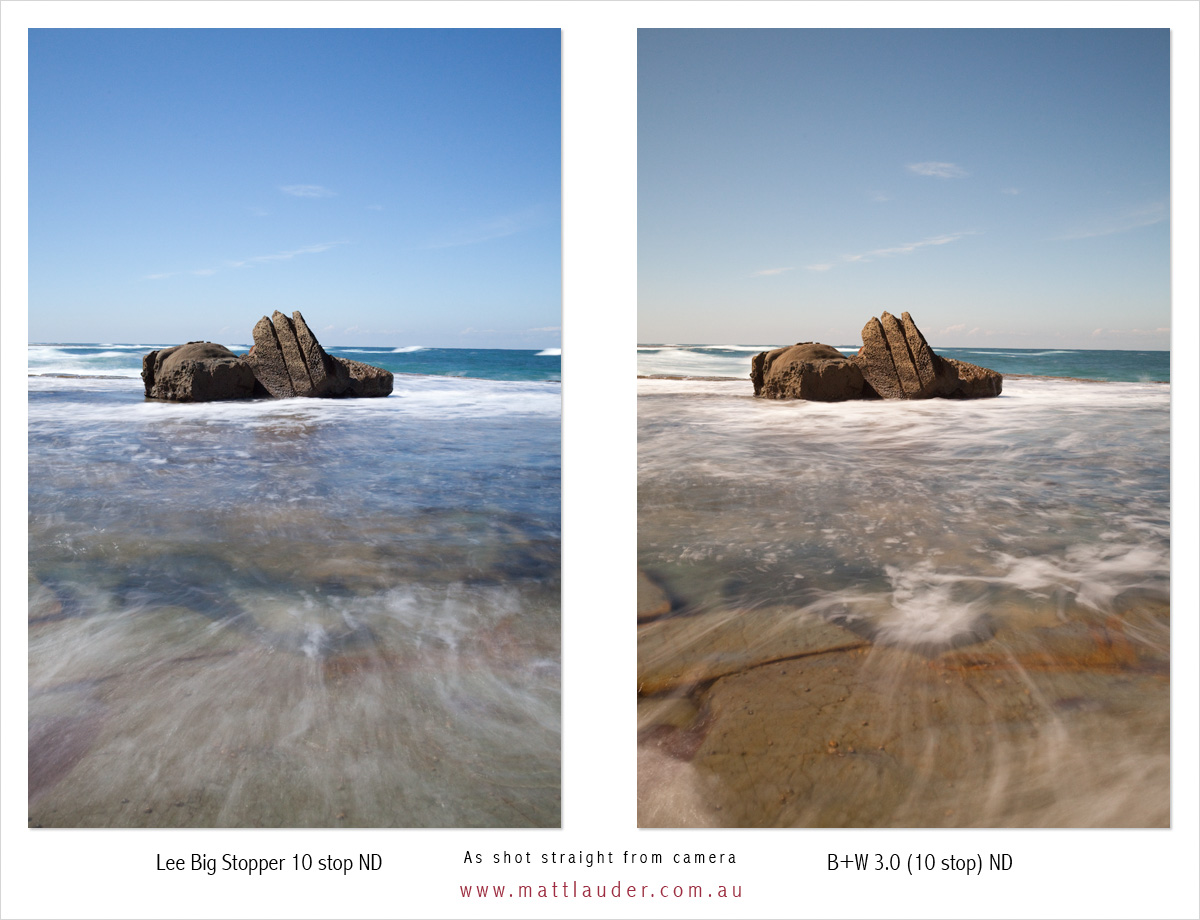
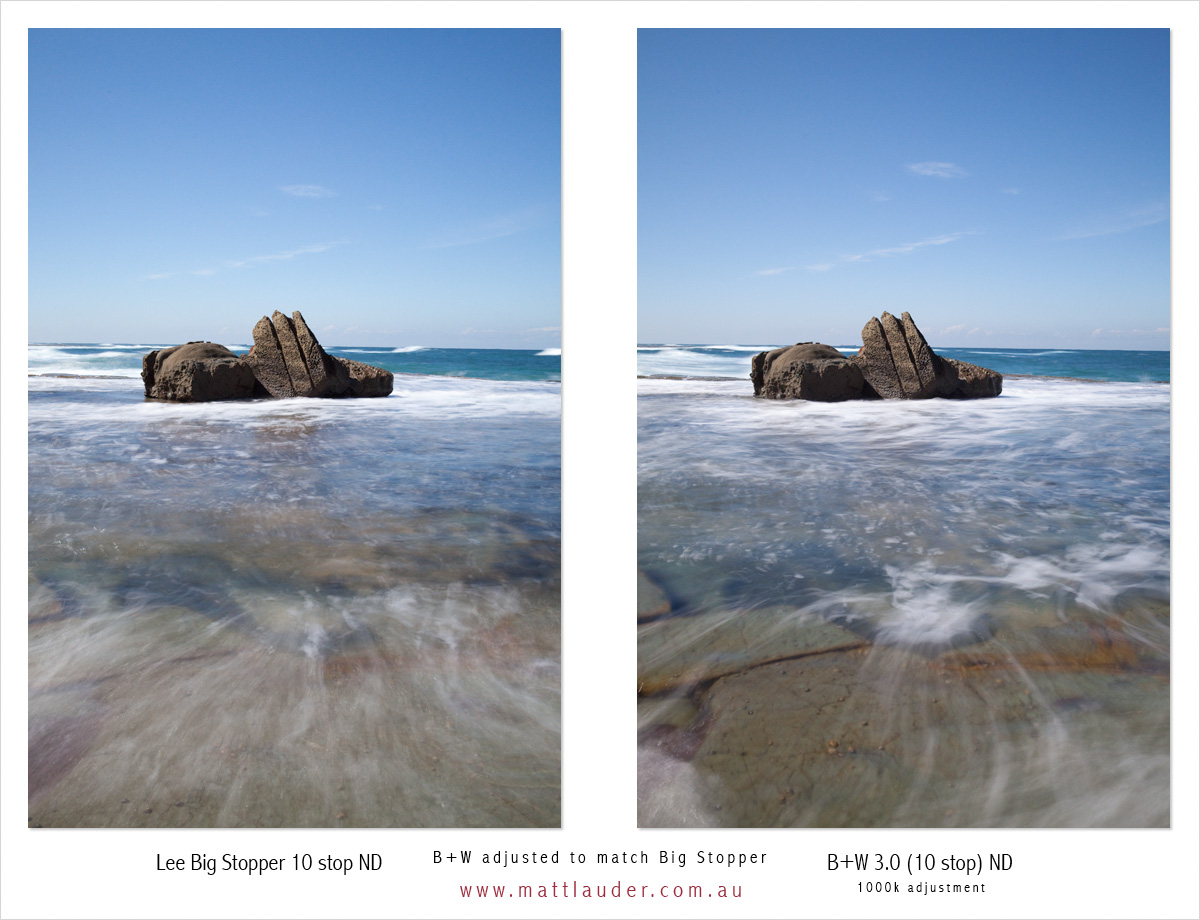
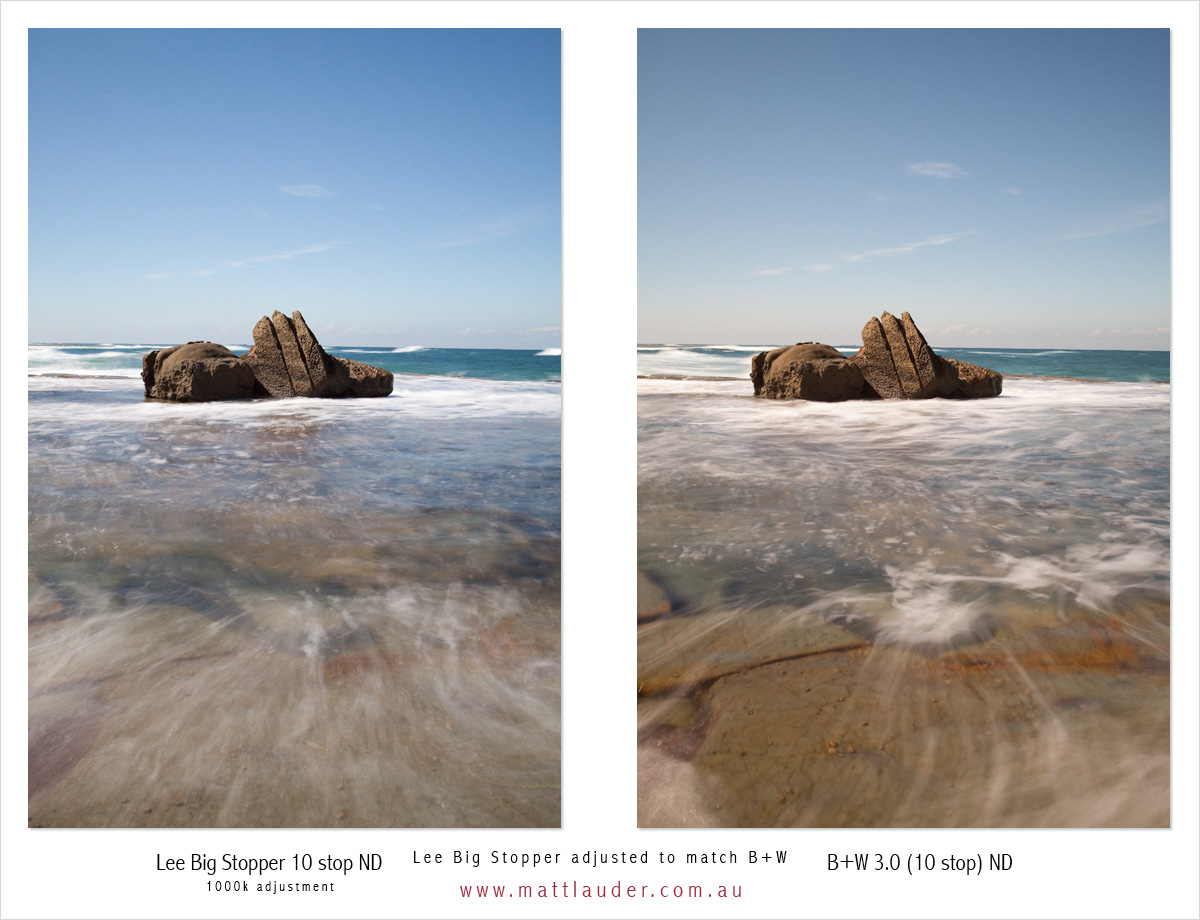

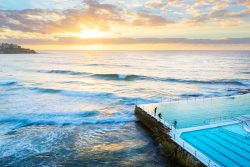

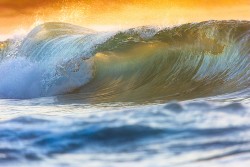
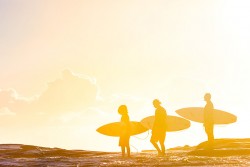

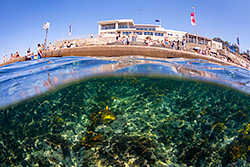




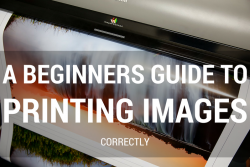
hmmm very interesting matt…i think i like the big stopper better just because you dont get that warm look to it, if you look at the first images the blues look way better in the big stopper photo….but when you made the the same kelvin i couldn’t see any difference between them…
when you shoot with film do u have to compensate for rep failure? and do u get a green tint to the photo ?
hmm but if i was going to buy a 10 stop i would get the big stopper just because it’s easier to re-focus if you have to
cheers
mitch
Thanks for the comparison Matt. I’ve got the B+W filter and I was curious as to the results you were going to get. Looks like I’ll save my pesos for now.
cheers, André
Yea save them would be my recommendation.
Nice one Matt, Great review from a ditigal perspective. Looks like the lee is exactly what I have been looking for. just need to find one. Kind wish it was more like 6-8 stop area though.
Ian
Thanks Ian, yea a 6 stop would be nice. After shooting with it some more I still like the B+W over the Lee.
You said you prefer the B+W over the Lee… any particular reason? Any thoughts on the B+W 10-stop vs the the Tiffen IRND 7-stop? I am using this with a Nikon D90.
got to get one of these bad boys
put it in front of my B&W get 20stop!!
just ease of use will lubricate the workflow
I’m pretty sure B+W does a 6.0 (20 stop). Blending the B+W and the Lee would be interesting. As the cast in each could almost cancel each other out. ?? worth a test that’s for sure.
When stacking ND’s, you don’t add the stops – they must be multiplied. Therefore 2x 10 stop filters stacked would be 100 stops. Useless unless you plan to shoot directly into the sun with a telescope.
B+W also produced (although now discontinued) a 13 stop ND and a 20 stop ND. Even 20 stops is a bit over the edge, but maybe B+W thought the same about 13 stops, hence why they were discontinued (I’m sure low sales were also a factor). I’m lucky have the 13 stop and it’s perfect for me, if still a little dark (imagine 2-4 minutes in bright sunlight). I’m looking to get a 10 stop for those situations when 13 is too much.
Is’nt 2 x 10 = 20
Pingback: B+W ND 110 y dominancia. - Canonistas.com
Patrick… not sure how you add up 2 x 10 stops = 100 stops. It is 20 stops. If I use a 10 stop and also a 3 stop it is 13 stops not 30. With each stop your shutter speed will double. So a 20 stop will give you a crazy long exposure.
I have used quite frequently a 10 stop and a polariser which is two stops extra so I have a 12 stop adjustment I can tell you that all I added was another two stops to get a perfect exposure. My adjustment wasn’t 20 stops.
It’s not 2×10= 100, it’s two 10 stops times EACHOTHER = 100.. I know what he meant. It’s really 10 (stops) x 10 (stops) = 100
Who on earth would stack ten 10 stop filters on the front of the camera. You wouldn’t even get a shot.
The stops are additive, not multiplicative. Consider stacking two filters, each reducing light by one stop. The total effect of the two stacked filters on light reduction is 1+1 (i.e., 2), not 1 x 1 (i.e., 1). mattlauder is correct. If you do not believe him, conduct a simple experiment with a light meter and you will learn the error of your logic.
Pingback: Lee 10 Stop ND filter “The Big Stopper” « Matt Lauder Landscape Photography
A very interesting comparison Matt. I too have done some testing between the Lee Big Stopper and the Hitech 10 Stop ND filter.
Lee Big Stopper and Hitech 10 Stop ND filter Review
Another thing I have to mention is be very careful with the Big Stopper. The other day I forgot I had it in my pocket and managed to snap the filter in two! The filter was in it’s pouch at the time but my own carelessness caused this. Now I have to wait months to source a replacement.
When you add ND filter you adding stops not multiplying it. 1 stop ND + 2 stop ND = 3 stop ND not 1×2=2 stop ND .. 🙂
Some people say when adding ND filters, stops will be multiplied. than, use 10 1-stop-ND, than result shall be?
Thanks for that review, I have the B+W 10 stop (and 6 stop) so will just stick with that for now. I have read of people getting a magenta colour cast with the B+W and this being the reason given for switching to Big Stopper but after using mine regularly for over a year now I haven’t had that problem at all. BTW, I have used my 10 stop B+W with a 3 stop Kood in mid (sunny) afternoon – normally a 6 or 8 second shot with the 10 stop and around 2 mins 15 seconds with the extra 3 stop on there too but there is quite heavy vignetting
I totally agree with what you said about the B+W filter being a pain in the ass… I always accidently leave AF on and then when I go to take the shot, it tries to focus but cant… If I’m lucky I realise before taking the shot, but usually I noticewhen it comes out blurry and then swear to myself a little. It’s even more frustrating with my Cokin ND grad filter and B+W circular polarising filter on, takes a good couple of minutes to unscrew and take all the filters off, refocus (remembering to turn the camera to MF this time!) and then put all the filters back on. I dream of using Lee filters and just being able to slide them in and out in seconds, I’m actually contemplating getting the Big Stopper and chucking the B+W 3.0 in the drawer, just to make things simpler and faster when I’m out and about taking photos!
Hi,
What about reflections when shooting UWA? The big stopper goes in front of the lens in a holder where light can get between filter and lens, so reflections and massive flare? Screw on will eliminate that. What is your opinion?
Gr. R.
Robert the Lee 10 stop ND filter is specially designed to be light tight with a special foam seal. Works perfectly.
Have you used this filter much Matt?
the ” X ” on the filter is for “Factor”, as in, the filter FACTOR in relation to SHUTTER SPEED and NOT a “Multiplier” used in MATH.
So 10X plus 10X = 20X , meaning, you need to COMPENSATE 20 steps of FULL SHUTTER SPEED COMPENSATION.
ALSO, the Filter FACTOR of 10 is only applicable to the shutter speed and not to the f-stop which has its own filter factor table.
Check the B+W Handbook.pdf on there web site.
“stops” are already logarithmic, therefore you add them.
I put a bright piece of tape with a note on my Filter Case to remind me that I have to focus first before screwing on the the ND filter. Works for me.
The Meltdownman